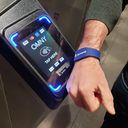Payment wearables are getting a boost from COVID pandemic

Bracelets, rings, key fobs and watches that double as credit or debit cards are enjoying a burst of popularity as COVID-wary consumers gravitate toward contactless payments.
Where it stands: While people have grown accustomed to waving their phones — or smart watches or Fitbits — in front of payment terminals, the next generation of wearables will likely be cheaper and/or more fashionable.
Driving the news: Several recent product launches point toward a future where payment features are built in to clothing and jewelry — and may include biometric features.
- A company called Purewrist introduced a payment bracelet that comes in six colors, costs $25, and can be used to spend up to $1,000 at a time.
- It's a linked to a reloadable Mastercard account that the wearer can manage online.
- At CES this year, a startup called Flywallet showed off Keyble, a "small smart module that fits into bracelets, watch straps and key rings" and uses the wearer's finger image to authenticate payments.
- On the high end, a European company called Armillon introduced limited-edition diamond-encrusted payment bracelets for men, which GQ UK says start at £38,130 ($52,000)
- ABN Amro, the Dutch bank, allows customers shop for payment rings, watches and bracelets through its website.
Of note: Europe is way ahead of the U.S. in its adoption of payment wearables.
- Some surveys show that smart rings, like the ones being issued by Belgium's KBC Bank, are the most popular form factor.
What they're saying: "We expect people to be using this for riding the MTA in New York or going and getting coffee, making small purchases," Suresh Palliparambil, CEO of Purewrist, tells Axios.
Flashback: This isn't the first time that banks and credit card companies have had high hopes for payment wearables.
- In 2015, Barclaycard and Topshop teamed up on a line of teeny-bopper accessories that doubled as payment cards (but are now discontinued).
- Every two years, Visa uses its sponsorship of the Olympics to showcase its payment wearables, including bracelets and "NFC-enabled gloves."
But, but, but: Some wearables may be ahead of their time, judging from a WSJ article about mobile wallets.
- "Problem is, many shoppers and cashiers have no idea how to use them," per the WSJ.
- "Even those who do find the major brands are still not accepted at the U.S. stores of some big retailers" like Walmart, Home Depot and Lowe’s.
The intrigue: Amazon is expanding use of its "Amazon One" payment terminals — which read your palm to authenticate a transaction.
- Under Amazon's vision, a biometric identifier — the palm image — would become a ubiquitous payment vehicle.